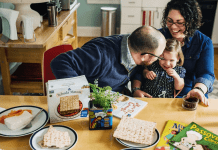My husband and I have walked into my late mother-in-law’s house for the last time.
We are in the process of settling her estate, including the sale of her house and disposition of everything in it.
From a hutch filled with china and crystal goblets to overflowing jewelry boxes and coin collections. And everything in between.
A lot in between.
Her clothes. The Notre Dame sweaters my late father-in-law was so fond of wearing. Her furniture. Furniture inherited from her mother-in-law, still in the same place in the garage where it was originally placed 30 some-odd years ago. My husband’s Cub Scout uniform. Christmas decorations. Lots and lots of Christmas decorations.
Every room, every closet, every shelf, every drawer. Full of stuff. A lifetime of stuff. Two lifetimes, if you count my father-in-law, who passed away 11 years ago.
What to Do With a Lifetime of Stuff
My mother-in-law was a neat and tidy housekeeper. But like many of us (myself included), she lived in a good-sized house with plenty of room to accommodate stuff. Things inherited from her parents and her in-laws. The broken vacuum cleaner waiting for repair in the back of the closet. Hundreds of books read once. You get the picture.
And the cost of disposing of all of that stuff? Having the estate sale company we hired go through every room, every closet, every drawer, separating the trash from the treasures, may cost more than will be generated at the eventual estate sale.
Her house has been transformed into a store, the estate sale company having cleverly arranged and displayed my mother-in-law’s possessions on tables in every room.
All of her possessions with any value, save the very few we kept, each with a tiny white price tag.
Losing your last surviving parent is hard enough. But being the arbiter of which of your parents’ and grandparents’ treasures get saved and which end up sold, donated, or in a landfill? gut-wrenching.
The lesson we have learned from this experience?
Most of the stuff in your house is worthless. And eventually, someone, either you or your kids, will be tasked with the overwhelming job of getting rid of it.
Most of Your Stuff Is Worthless
Most of the stuff in your house is worthless.
Yes, even the stuff you worry the most about, the stuff you think is so good you don’t use it for fear of breaking it, has little to no resale value.
From china, china cabinets, crystal goblets, silver tea sets, pianos, and collectible figurines like Hummels, to grandfather clocks and real pieces of craftsmanship furniture.
Why? Baby boomers have glutted the market with their castoffs, and millennials, the next generation of buyers, don’t want it.
Millennials hate both formal in-home entertaining and use of second-hand goods. With looming student loans, they tend to rent and move often. Who wants to be constantly moving a piano and a grandfather clock from apartment to apartment?
And furniture? There’s no market for so-called “brown furniture,” meaning any furniture (regardless of quality) other than the “mid-century casual” furniture (think clean, lightweight) favored by millennials. Brown furniture is basically firewood.
If it’s not in great condition, it’s also not fit for donation because it can’t be resold.
All of my mother-in-law’s furniture (including the pieces inherited from her mother-in-law and kept for decades)? Straight to the landfill.
Well, Almost Everything…
What do guns, LPs (records), and precious metals/gems have in common?
They are 3 things you might have in your house with a robust resale value.
Silverware also has value, but only if it is real silver and can be melted down.
3 Things You Should Be Doing NOW to Reduce the Amount of Stuff You Have
1. Be viciously thoughtful about holding onto sentimental items.
Here was our goal with sorting through my mother-in-law’s things. Keep just enough to remind us of her, but not so much stuff that our daughters are going to be dealing with it 40 some-odd years from now.
Here’s what we kept:
- A painting to be displayed in our dining room
- My mother-in-law’s treasured Swarovski crystal animal collection (all of which were given to her by her children and grandchildren over the years)
- Jewelry to be divided among the granddaughters
- Each of our daughters got to select 1 item
And that was it.
Well, almost. We did set aside photos to be digitized (with the originals then destroyed).
Was it hard leaving everything else? You bet it was. But we don’t want to be dealing with a lot of stuff years from now (or worse, leaving it to our daughters to deal with).
I try to be viciously thoughtful with my own sentimental items. For example, I don’t save any school papers or art projects from my kids (though I do take photos of my favorites).
2. Buy fewer books.
While used book resellers like Half Price Books do an important service in keeping books in circulation, a surprising number of books end up in landfills because many paper recycling facilities can’t process the the glue that binds book spines.
My resolution last year was to cut down on my book consumption by only reading books that I borrow from the library or purchase on my Kindle e-reader. If you haven’t used a library in years, now is the time to go back. My local library has an app where you can “order” books online, and pick them up the next day on a special “hold” shelf strategically placed next to the check-out kiosk.
How successful was I on my resolution? I read 1 to 2 books a week in 2019, only 1 of which was a hard copy purchased from Amazon.
3. Buy fewer, but better quality, clothes
The world is overflowing with used clothing.
We buy substantially more clothing over our lifetimes than our grandparents did.
Clothing made today is meant to last no more than a few years. In fact, a lot of clothing isn’t even made to withstand more than a few washes.
Think you are “paying it forward” but dropping off a load of unwanted clothes at Goodwill? Think again. Most clothing donations never make it to the racks at Goodwill and only about a third of what does eventually sells.
To really pay it forward, cut down on the amount of clothing you have by buying better quality clothes that last longer.
Keeping What Really Matters
My 5-year-old chose to keep a Christmas music box from her Grandma’s house. It plays “White Christmas” and has tiny ice skaters going around a rink inside. Each Christmas, my mother-in-law would bring out this music box and let each of her granddaughter’s play with it. It’s value in preserving a precious memory of Grandma? Priceless.














Our country has a housing and food crisis. So you don’t like “brown” furniture and consider it worthless. Well the homeless person who finally got approved for an apartment or a family has an apartment with almost nothing to put in it. Or a family of 5 all sleep in the same bed because they can’t afford to buy another one. Maybe that family of 5 has no sheets or blankets, and when it’s cold, they sleep in their winter coats. There are the families that use boxes for a kitchen table and have a couple broken down chairs. Go online and look for organizations that will accept the furniture and clothing. In Columbus, Ohio, we have the Furniture Bank, which accepts donations and works with families to get them furniture for their home. Then there are the free stores that people come in and pick out clothing, shoes, utensils such as toasters, forks and knives, cups, microwaves, lamps, etc. And yes, there are all the traditional organizations, Goodwill, Salvation Army, Red Cross, etc. The saying, what’s one person’s trash is another person’s treasure, really applies here. That fancy dish setting, instead of only having cheap, unmatched, chipped dishes and utensils, some families may like having something nice in their home. Old toys that aren’t missing any parts, there are people begging for even one toy to give their child for Christmas or birthday. For the individual who has just gotten a job, or only has one raggedy set of clothes and shoes to wear to school, they would probably love the opportunity to choose any of the never before worn clothing in your mother’s or grandfather’s closet. Same for teenagers who aged out of the foster care system and have left their caretakers homes.
Do a search for Blessing Boxes and see what comes up. These are stocked with non-perishable food items, basic toiletries, baby supplies, and anything else that might be considered a blessing to someone who finds themselves in need. Items are anonymously donated and anonymously received. Some of these boxes ask for book donations, for children and adults; a Book Blessing Box may be close by, while a library may be several miles away. Even if you’re not disposing of your parents “junk” give some thought to donating to one of these organizations.
Used to buy several books a month, but a few years ago reached a point where there are only two authors that I buy, everyone else, borrow from the library. Those photos you don’t want because even if there are names on the back, you don’t know who they are. While you’re at the library, ask if they have Ancestry or Family Search or another genealogy program on their computers, and do a search to see if any of those names come up. Check to see if there is a local genealogical society that may would either like the collection or point you in the right direction. Genealogy has become a major hobby for people and we’re always on the lookout for photos, whether from 20 or 150 years ago. Ebay has become a place to go when looking for old photos or even bibles or marriage licenses.
I’m not going to stop buying items that interest me, and if my family wants to dispose of it after I’m gone, that’s fine. Just be sure to check with my genealogy buddies first to see if they want any of my research books or photographs. Then you can donate the rest of my “stuff” to one of the organizations I mentioned.
Please disregard the author’s advice to digitize and destroy old pictures. Please! Technology changes rapidly and all the tech that seems state of the art now will be obsolete next year. The chances of your digital photo history surviving you is slim. Yet we can all look a photographs from more than a century ago.
I guess you could call me a millennial if you wanted. At 32 I feel sad that myself and my sisters have no special family heirlooms to pass down… Sure, maybe YOUR kids haven’t thought about, but that’s because they are kids and can’t realize the value yet?? Maybe, one day, like me, it will dawn on them that you CAN’T go buy family heirlooms at Walmart. Put that into perspective and you might feel better about the hard work you are doing. I saydo what you can to preserve your prescious family history. Once it’s gone you can’t get it back!! At least try and take the time to do as much documenting as you can or give other people in the world a chance to decide if it’s worth something before sending it to the landfill… Who knows, maybe that brown furniture will make a come back in style! It has in my house. I love tea pots, table settings, all things that remind of the past. Old portraits of dead people who I will never know. I LIKE IT. You know why? Because it’s one of kind. I treasure these things and even though they aren’t MY family heirlooms, they have been adopted and I want to love them 🙂
My two cents. Done with IKEA. I live for the estate sale.
Great post! I hear Martha Stewart as part of the Distinguished Speakers Series in Southern California and she told the audience to get rid of their stuff! The Swedes have a thing called Swedish Death Cleaning that is actually a great tradition to start.
We live in such a throw away society. Don’t reuse solid furniture just buy cheap new. Get tired of it and buy new. The same people that want to save the planet. Sad
Exactly
Do all antique dealers and collectors a large favour and stay at home. Obviously your field of expertise must be wiping noses and vacuuming carpets.
So, apparently Gen X doesn’t exist in this writers world..
I dealt with the same issue in 2017. Before I did anything I let family come to Mom’s house and take what they wanted. I absolutely refused to have an auction!! I saw my neighbors go through an auction and it was heartbreaking. So….I packed everything up and called Salvation Army. They took everything except a couple mattresses. Dad always said Salvation Army was at the “front” during WWII…..so i called them. I had peace eventhough it was hard to sell my childhood home.
As a successful Estate Sale Liquidator I have seen many smiles on the faces of heirs when I hand them a check for $10K + for the sale of their parent’s treasures. This is after we have staged, set up, priced and advertised the items, finding new happy homes for their treasures. I have also seen an abundance of items the heirs choose to keep. While you may speak for yourself as far as your husband’s parents…..the same is not for everyone. 😉
Please consider donating to your local Habitat for Humanity Restore when purging. The proceeds from selling donations go to help families that need housing both in your community and all over the world. A secondary benefit is that their efforts keep tons of furniture, construction materials, tools, appliances and other household goods from the landfill. I volunteer at our local Restore and I am impressed with every aspect of their operation. Helps to know your family’s stuff is not only being recycled, but supporting those in need of housing. Check it out.
We did try to donate to Habitat for Humanity. They took about half of what we had (which was all in good condition). Turns out they are a bit fussy about what they take because several of the items “wouldn’t sell”. They sell what is donated and use the proceeds for purchasing items. I am not saying do not donate. Just letting folks know they may not take everything you would like to donate. This may only be true for the program where we live.